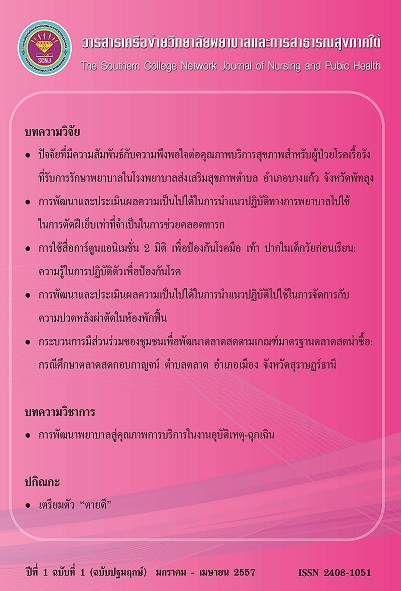การพัฒนาและประเมินผลความเป็นไปได้ในการนำแนวปฏิบัติทางการพยาบาลไปใช้ ในการตัดฝีเย็บเท่าที่จำเป็นในการช่วยคลอดทารก
คำสำคัญ:
แนวปฏิบัติทางการพยาบาล, การตัดฝีเย็บ, Clinical Nursing Practice Guideline, Restrictive Episiotomyบทคัดย่อ
การตัดฝีเย็บในการช่วยคลอดทารกควรทำเท่าที่จำเป็นการวิจัยครั้งนี้จึงมีวัตถุประสงค์เพื่อพัฒนาแนวปฏิบัติในการตัดฝีเย็บเท่าที่จำเป็นในการช่วยคลอดทารกและประเมินความเป็นไปได้ในการนำไปใช้ การศึกษาประกอบด้วย 1) การพัฒนาแนวปฏิบัติ โดยประยุกต์ใช้ขั้นตอนการพัฒนาแนวปฏิบัติทางคลินิกของสภาการวิจัยทางการแพทย์และสุขภาพแห่งชาติ ประเทศออสเตรเลีย ผ่านการตรวจสอบความตรงตามเนื้อหาโดยผู้ทรงคุณวุฒิ 3 ท่าน และ 2) การประเมินผลความเป็นไปได้ในการนำแนวปฏิบัติไปใช้และความพึงพอใจจากพยาบาลผู้ใช้แนวปฏิบัติ จำนวน 14 ราย และผลลัพธ์ทางคลินิกในผู้รับบริการที่ได้รับการดูแลตามแนวปฏิบัติ ระหว่างวันที่ 1 ตุลาคม 2556 ถึง 31 มีนาคม 2557 จำนวน 416 ราย เครื่องมือในการเก็บรวบรวมข้อมูล ได้แก่ แบบสอบถามความเป็นไปได้ของการนำแนวปฏิบัติไป ใช้ แบบสอบถามความพึงพอใจของพยาบาลผู้ใช้แนวปฏิบัติและแบบบันทึกการดูแลระยะคลอด โดยใช้ สถิติเชิงบรรยายในการวิเคราะห์ข้อมูล
ผลการวิจัย พบว่า แนวปฏิบัติทางการพยาบาลในการตัดฝีเย็บเท่าที่จำเป็นในการช่วยคลอดทารกที่พัฒนาขึ้นประกอบด้วยเนื้อหา 2 ด้าน คือ 1) การตัดฝีเย็บในการช่วยคลอดทารก และ 2) การป้องกันการฉีกขาดของช่องทางคลอด ส่วนการประเมินผลความเป็นไปได้ในการนำแนวปฏิบัติไปใช้ พบว่า มีความเป็นไปได้ในการนำไปใช้โดยรวมอยู่ในระดับสูง และพยาบาลผู้ใช้แนวปฏิบัติมีความพึงพอใจในระดับมากร้อยละ 100 ผลลัพธ์ทางคลินิกในผู้รับบริการที่ได้รับการดูแลตามแนวปฏิบัติ พบว่า มีการตัดฝีเย็บในการช่วยคลอดทารกร้อยละ 36.30 ผู้รับบริการที่ไม่ได้ตัดฝีเย็บในการช่วยคลอด ร้อยละ 63.70 พบว่า ไม่มีการฉีกขาดของฝีเย็บ ร้อยละ 60 ฉีกขาดระดับ 1 ร้อยละ 35.47 ฉีกขาดระดับ 2 ร้อยละ 4.53 และไม่พบการฉีกขาดของฝีเย็บและหูรูดทวารหนักระดับ 3 และระดับ 4
ผลการวิจัยครั้งนี้แสดงให้เห็นว่าแนวปฏิบัติทางการพยาบาลในการตัดฝีเย็บเท่าที่จำเป็นในการช่วยคลอดทารกที่พัฒนาขึ้นสามารถนำไปใช้ได้ โดยไม่เกิดผลกระทบหรือภาวะแทรกซ้อนกับผู้รับบริการ
Development and Feasibility Evaluation of Clinical Nursing Practice Guidelines on Performing Restrictive Episiotomy during Childbirth
Restrictive Episiotomy during childbirth should be done only when necessary. It is not a routine practice. The present research aimed to develop the Clinical Nursing Practice Guideline (CNPG) of performing restrictive episiotomy during childbirth, and evaluate its feasibility. The study was divided into two phases: 1) developing a CNPG based on the guideline development of the National Health and Medical Research Council of Australia (contents validated and approved by three experts) and 2) evaluation of the CNPG’s feasibility and satisfaction of 14 midwives who implemented the CNPG, and 3) evaluation of clinical outcomes of 419 mothers who were admitted in a hospital for six months; it is to say from October 1, 2013 to March 31, 2014.Research instruments consisted of: 1) the feasibility evaluation form, 2) the satisfaction toward using CNPG questionnaire, and 3) the labor documentation. Data was analyzed using descriptive statistics.
The results revealed that the developed CNPG contents composed of 2 domains: 1) performing episiotomy during childbirth, and 2) perineal protection. The feasibility and the satisfaction of the CNPG as evaluated by the midwives was at a high level. The CNPG was implemented in all 416 singleton cephalic vaginal deliveries. The medio-lateral episiotomy was performed in 36.30% of the sample-- 60 % with intact perineum, 35.47 % with first-degree perineal laceration, 4.53 % with second-degree perineal laceration. No third- or fourth-degree perineal laceration was found.
The findings showed that the developed CNPG is effective and should be implemented for performing restrictive episiotomy in singleton cephalic delivery.
ดาวน์โหลด
เผยแพร่แล้ว
ฉบับ
ประเภทบทความ
สัญญาอนุญาต
1. บทความหรือข้อคิดเห็นใด ๆ ที่ปรากฏในวารสารเครือข่าย วิทยาลัยพยาบาลและการสาธารณสุขภาคใต้ ที่เป็นวรรณกรรมของผู้เขียน บรรณาธิการหรือเครือข่ายวิทยาลัยพยาบาลและวิทยาลัยการสาธารณสุขภาคใต้ ไม่จำเป็นต้องเห็นด้วย
2. บทความที่ได้รับการตีพิมพ์ถือเป็นลิขสิทธิ์ของ วารสารเครือข่ายวิทยาลัยพยาบาลและการสาธารณสุขภาคใต้








